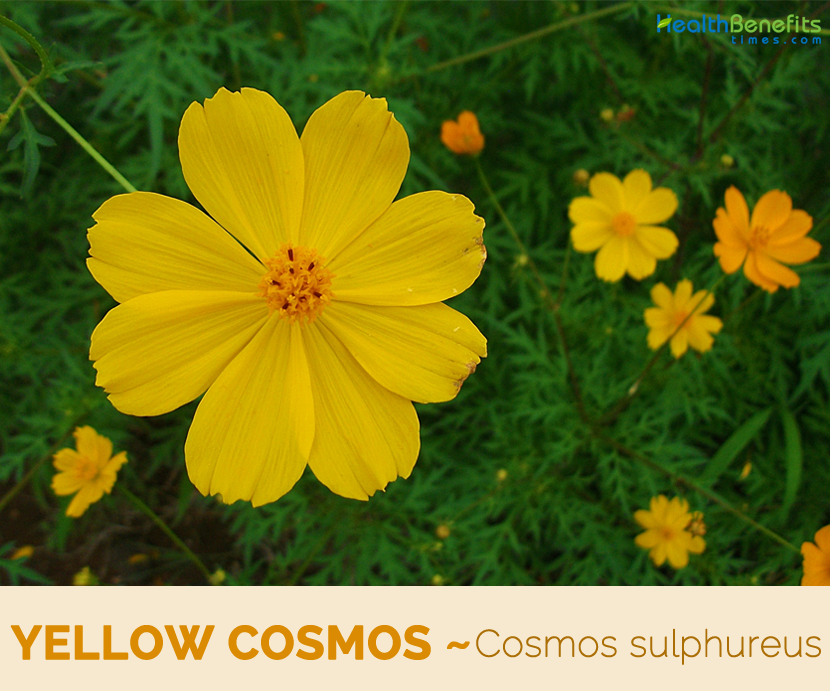| Yellow Cosmos Quick Facts | |
|---|---|
| Name: | Yellow Cosmos |
| Scientific Name: | Cosmos sulphureus |
| Origin | Mexico in Central America |
| Shapes | 2 cm achene, hispid, blackish, spindle-shaped pappus absent |
The plant is mainly popular in Korea and Japan, where it is often seen in mass plantings along roadsides, following an inventiveness followed by the Korean-Japanese botanist Woo Jang-choon. The plant was declared invasive by the United States Southeast Exotic Pest Plant Council in 1996. The plant is harvested from the wild for local use as the source of a dye and as a medicine. It is commonly grown as an ornamental, there are many named varieties.
Plant Description
Yellow Cosmos is an annual robust, erect herbaceous plant that grows about 1–7 feet (30–210 cm) tall with terete, slightly compressed, and sparsely pubescent to glabrescent and green stem. The plant is found growing in adventive lands along roadsides, in damp meadows, on brushy slopes, also cultivated and escaping as a garden weed and thrives in average, medium moisture, moderately fertile, well-drained soils. The plant can also tolerate poor and dryish soils. Avoid rich fertile soils because plants may grow too tall and flop over. Leaves are opposite, sessile or shortly petiolate; outline broadly ovate-rhomboid, 2–4 pinnately dissected with ultimate segments narrowly linear-lanceolate, 2.5 mm wide, apiculate and glabrous.
Flower & Fruit
Inflorescence is terminal or axillary, solitary, 1.5 cm across, peduncle 1–2 cm long, outer involucral bracts narrowly ovate, acuminate, inner involucral bracts with membranous margins. Ray florets are obovate, intensely yellow to deep orange, apex denticulate. Disc florets with narrowly funnel- shaped corolla, yellow, orange-yellow, 6–7 mm. Some popular cultivars of this species are in many cases compact to dwarf plants with semi-double to double flowers and with flower colors ranging from orange to yellow to scarlet red. They come after spring to brighten the garden for the summer. Flowers are followed by 2 cm achene, hispid, blackish, spindle-shaped pappus absent or of 2–3 widely divergent awns. Plants will sometimes self-seed, mostly if seed drops on bare ground. Self-seeding may rise to the level of being aggressive in some climates and conditions. Seed may be harvested in fall for planting the following spring.
Origin and geographic distribution
Cosmos sulphureus originates from Central America (Mexico) and northern South America, where it is still found in the wild. It has been introduced as an ornamental in many countries all over the world, in tropical Africa e.g. in Senegal, Cameroon, Sudan, Tanzania, Malawi, Zambia, Zimbabwe, Mozambique, Reunion and Mauritius. Sometimes it has escaped from cultivation and acts like a weed, e.g. in Tanzania, Malawi, Zimbabwe, the United States and Canada. Today it is found throughout the world due to its wonderful looking flower and other benefits.
Traditional uses and benefits of Yellow Cosmos
- The leaves are used in native medicine in Indonesia and in Brazil for malaria.
- The rhizomes are used in the treatment of malaria.
Culinary Uses
- The young shoots and leaves are eaten as vegetables raw or cooked as ‘lalab’ or ‘gudang’ with rice in Indonesia.
- The flowers are edible and use in salads in Thailand.
Other Facts
- A popular ornamental plant in cottage gardens and public places, commonly seen in mass planting along roadsides, beds and borders in Korea and Japan.
- Flower heads of Cosmos sulphureus and other Cosmos, Bidens and Coreopsis species have provided important sources of yellow to orange dyes among the pre-Columbian civilizations of Central and South America.
- In southern Africa, they were adopted as a popular yellow dye by European settlers for domestic textile production and are still used by dyers using natural dyes as a hobby or for textile crafts, to dye wool bright yellow or orange.
- Flowers of all Cosmos including this species attract birds and butterflies.
References:
https://www.itis.gov/servlet/SingleRpt/SingleRpt?search_topic=TSN&search_value=37165#null
https://davesgarden.com/guides/pf/go/218/
https://npgsweb.ars-grin.gov/gringlobal/taxonomydetail.aspx?id=11684
https://www.cabi.org/isc/datasheet/110395
http://www.missouribotanicalgarden.org/PlantFinder/PlantFinderDetails.aspx?taxonid=277308
http://www.theplantlist.org/tpl1.1/record/gcc-129696
http://uses.plantnet-project.org/en/Cosmos_sulphureus_(PROTA)
https://en.wikipedia.org/wiki/Cosmos_sulphureus
Comments
comments
